The Number 6SL Brake Stand
The automatic brake valve quadrant has six
positions:
Quick Charge, Release, Hold, Lap, Service and
Emergency.
This is the large handle in the photos below.
Thanks to engineer Robin Becker for the following
video demonstrations.
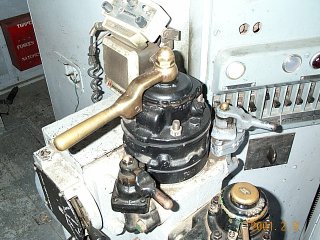 (1)
Quick Charge: Located to the extreme left of
the quadrant, is used for a quick charging of the air brake system.
This position is used infrequently.
(1)
Quick Charge: Located to the extreme left of
the quadrant, is used for a quick charging of the air brake system.
This position is used infrequently.
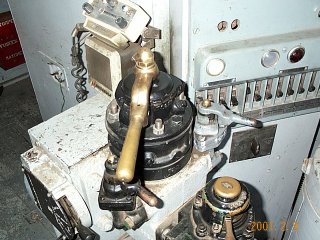 (2)
Release: Located in the first notch to the
right of Quick Charge, is used to release and recharge the brakes. This
is the normal running position. When moving the lever, the experienced
engineer can feel the detents and make the move without taking his eyes
off the tracks ahead.
(2)
Release: Located in the first notch to the
right of Quick Charge, is used to release and recharge the brakes. This
is the normal running position. When moving the lever, the experienced
engineer can feel the detents and make the move without taking his eyes
off the tracks ahead.
Video of a release (1.4MB mpeg)
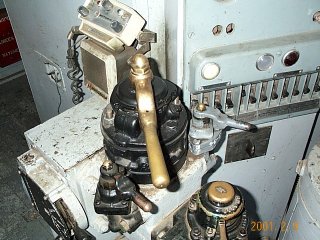 (3)
Hold: Located in the notch to the right of Release, is
used to release the train brakes while maintaining a set on the engine
brakes.
(3)
Hold: Located in the notch to the right of Release, is
used to release the train brakes while maintaining a set on the engine
brakes.

(4) Lap: is against the
shoulder to the right of Hold, is used to close all ports after a
service reduction.
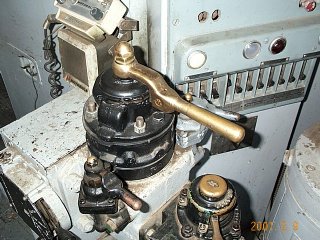 (5)
Service: Area where brake pipe pressure can
be reduced at a service rate. Length of time in this area determines
how much reduction is made. The independent brake also applies at this
time.
(5)
Service: Area where brake pipe pressure can
be reduced at a service rate. Length of time in this area determines
how much reduction is made. The independent brake also applies at this
time.
Video of a 20 lb. reduction (1.8MB mpeg)
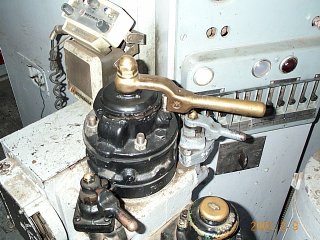 (6)
Emergency: Located at the extreme right of the quadrant is used for
making an emergency brake application.
(6)
Emergency: Located at the extreme right of the quadrant is used for
making an emergency brake application.
Video of an emergency application (1.6MB mpeg)
The independent brake valve controls the engine's
brakes, and has two positions:
Release and Apply
The automatic brake is not affected by the
application or release of this
brake.
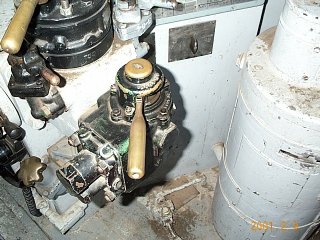 (1)Release: Located to the
extreme left, is used to release an engine brake application. An
application of the automatic brake also causes the independent to be
applied. If the engineer desires to release his engine brakes at this
time while keeping the train brakes applied, he presses down on the
independent lever. This is called "bailing" the independent, and keeps
the engine stretched out from the train.
(1)Release: Located to the
extreme left, is used to release an engine brake application. An
application of the automatic brake also causes the independent to be
applied. If the engineer desires to release his engine brakes at this
time while keeping the train brakes applied, he presses down on the
independent lever. This is called "bailing" the independent, and keeps
the engine stretched out from the train.
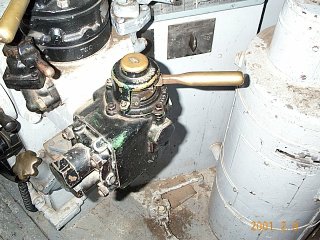 (2)
Apply: Located to the extreme right, is used to make a maximum
engine brake application, usually during a stop. Positions between
Release and Apply provide a continuously variable amount of application.
(2)
Apply: Located to the extreme right, is used to make a maximum
engine brake application, usually during a stop. Positions between
Release and Apply provide a continuously variable amount of application.
Last updated on 17 March 2013
 (1)
Quick Charge: Located to the extreme left of
the quadrant, is used for a quick charging of the air brake system.
This position is used infrequently.
(1)
Quick Charge: Located to the extreme left of
the quadrant, is used for a quick charging of the air brake system.
This position is used infrequently.
 (2)
Release: Located in the first notch to the
right of Quick Charge, is used to release and recharge the brakes. This
is the normal running position. When moving the lever, the experienced
engineer can feel the detents and make the move without taking his eyes
off the tracks ahead.
(2)
Release: Located in the first notch to the
right of Quick Charge, is used to release and recharge the brakes. This
is the normal running position. When moving the lever, the experienced
engineer can feel the detents and make the move without taking his eyes
off the tracks ahead.





